There are horses, and there are special horses - then, once or twice in a lifetime if we’re lucky, there’s that horse that just changes your life.
For Karoline Østergaard Nielsen that horse was Cantabernet, aka ‘Cabbie’. Things like anxiety and lack of confidence disappeared to a great degree when Cabbie’s love entered Karoline’s life, but then on January 26th tragedy struck. By Rachel Oenema.
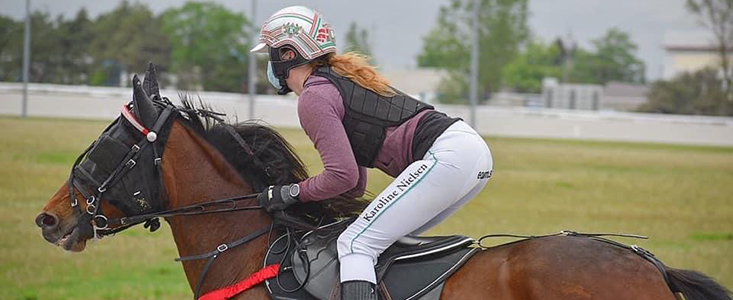
PERHAPS one of the most common unwritten rules in harness racing is the “it’s a business, so don’t get attached to them” rule. Many, however, that actually work in this business think this ‘rule’ sucks… Because this simply isn’t just a business. I know it, you know it, we all know it. We all know this is a lifestyle, it’s a lifestyle of taking care of these amazing equine athletes day in and day out, putting their needs first before ours, and making sure they are fed and exercised before some of us even have our first meal of the day. It’s a lifestyle of knowing that if you only had $20 left to your name, you would use it to feed your horse before yourself because you love them more than your own existence.
When you live this lifestyle, it is nearly impossible not to get attached to these horses we spend every day of our lives with.
Karoline Nielsen is one of the most passionate individuals in this industry, and she totally agrees that it is nearly impossible to never get attached to any of the horses you take care of.
Nielsen’s journey in the Standardbred world isn’t your typical born-and-raised into the business. Her journey, which started eight hours across the Atlantic Ocean in Denmark, is one where she actually didn’t want anything to do with Standardbreds - at first.
“I used to ride Thoroughbreds for my aunt, I really didn’t have any interest in Standardbreds. After high school I needed a year to figure out what I wanted to do, my mom’s, co-worker’s husband was a Standardbred trainer and he said that there was a trainer at the same training centre that was looking for help,” Nielsen explains.
“I started working for him and was there full-time for a year, but in that year I never jogged a horse. I just harnessed, bathed, mucked stalls. I never went to the races either. I actually remember telling him that I really have no interest in Standardbreds because I thought it was boring,” she says with a laugh. “But I told him that if he wanted the horses exercised I could ride them for him - and I ended up breaking all of his horses for him to saddle, so I rode all the horses instead of jogging them.”
However, a tricky trotter in the Arvid Olsen stable, where Karoline was employed, gave her a reason to start visiting the racetrack.
“When I previously worked with the Thoroughbreds I had a dream of being an amatuer rider. In Denmark they have a licence course you have to take to get your [Standardbred] under-saddle license. I did that and I got my license in September of 2011 but I didn’t ride in a race until April of 2012, and that was only because we had a horse who couldn’t stay flat in the bike so my trainer wanted him to try and race under-saddle.
Once I started riding in races I fell in love with it right away,” she humbly reminisces.
While racing under-saddle is still finding its popularity in North America, it is a valued form of alternative racing in European countries.
“In Denmark there are over 100 riders and about three to four RUS races a week,” Karoline explains.
It was through her love of monté racing and social media, that Karoline became in contact with some of the Canadian RUS riders while still living in Denmark.
“I had been riding for four years already when I started being in contact over Instagram with some of the RUS riders from here. One of the girls told me that I should come and visit them and ride in some races here. I came here to visit for two weeks and stayed with Pam Forgie up in Clinton. When my two weeks were up I was so devastated that I had to go home. It’s not like I had nothing to leave back home either, I had an apartment, a job in retail, I had everything at home. But, I went back and quit my job, I gave up my apartment and I moved here to work with Standardbreds,” Nielsen says confidently about her decision.
“I lived with Pam for a year when I moved here but Clinton and Godrich were too small for me, so I moved to Cambridge and started working for Tony O’Sullivan. After working for Tony I started working for my eventual boyfriend Nick Gallucci.”
Perhaps this is where Karoline really started to feel the effects of one of the most amazing experiences in the world - falling in love with a racehorse.
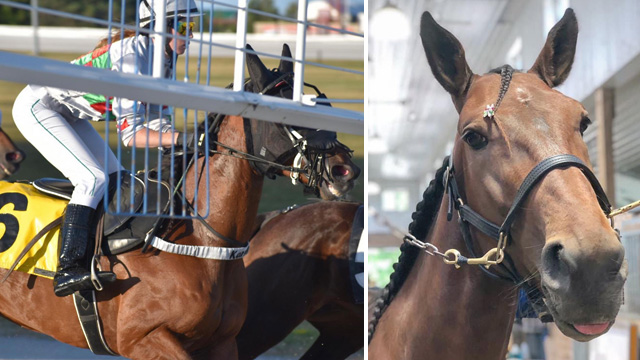
“Docs Sausalito aka ‘Saucy’ was the first Standardbred I owned part of... I owned 10% of her with Nick. She was an extremely evil horse to most people,” she laughs, “but for some reason I had a great connection with her. I loved her and she was very special to me. She really wasn’t a nice horse to be around, she wasn’t a horse that anyone could just do anything with.
“She was claimed from us a few times, and we would go and claim her back, and she would get claimed again. Eventually the back-and-forth got to be too much and she was in for a price that was too much for us so I had to find it in me to just let her go.”
Nielsen continues to explain the feeling of having one of your favourite horses claimed, a feeling that is one of the most heart-wrenching emotions you can feel.
“Claiming races are something that I never knew about until I came to Canada, we don’t have claimers in Denmark. Here in Canada everyone thinks that this business wouldn’t survive without claimers and I completely disagree with that... it’s the way you write conditions but that isn’t up to me.”
“It hurts me because these horses go out and race so honestly for us but we are basically putting them up for sale, it doesn’t get to matter how much we love our horses. One of the worst parts of it is when your horse has just raced their heart out for you and you don’t get to take them home and they don’t understand why. It is completely heartbreaking.”
If you’ve had a favorite horse claimed off of you before, you know the feeling Nielsen describes: the feeling of walking into work the next morning to see an empty stall, the first morning without their morning knicker to you, the feeling of stalking the entries the following week to see if they are back into race, and the feeling of watching another person race your horse, all while feeling the nervousness to go up and ask their new trainer if it is okay for you to say hello to an old friend.
But, as with anything, life has to go on, and this prompted Karoline and boyfriend Nick to look for another horse.
“Nick and I had been talking about getting another horse for us, more specifically a trotter that I could hopefully race under-saddle. We started looking around for a trotter but there wasn’t much around. One night we noticed a horse entered to race at Flamboro in against one of our other horses and it was his first start in a claimer.
“We watched the horse warm up, he was a little small but we took a shot and put a claim in on him. I think there were about three other claims on him that night. I remember hearing that there were other claims in on him and thinking it will be just our luck that we don’t get him.”
“But we ended up getting him…”
Thus on May 9, 2019, began the journey and love story of Karoline and a bay Cantab Hall gelding named Cantabernet… aka ‘Cabbie’.
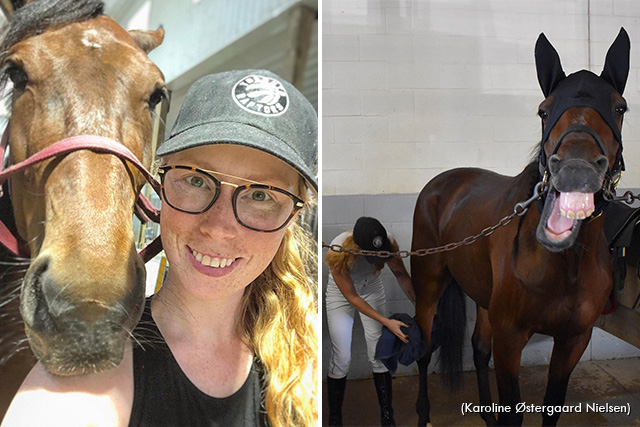
Cabbie didn’t take long to settle into the barn of Nielsen and Gallucci where he would quickly learn the under-saddle ropes.
“After we got Cabbie I broke him to ride a few days later. He was a sweetheart but he was not by any means an easy horse to ride. He struggled to figure out his balance with me on top of him and it was actually really difficult to figure out how to ride him.
“I took him to qualify under-saddle at Grand River Raceway in June, where we learned quickly that he wasn’t really a half-mile horse because of how he struggled in the turns, and even though he raced on half-mile tracks at times, he was never very successful in doing so. I kept him pretty wide in the qualifier, where he ended up winning, but it wasn’t in any impressive fashion.
“In his first RUS race at Hanover Raceway he made a break on the first two turns, but his second RUS race at Georgian Downs he was second and he stayed flat, and he really wasn’t beat much for the win,” Karoline says with the excitement in her voice still so prominent.
“I remember being so proud of him. I can easily say he is the hardest horse I have ever ridden because he was so hard to keep together in the turns, but he would try so hard for me and it just made me feel this sense of pride that I had never felt before.”
And perhaps it was that pride in her horse that really justified the love that would grow between Karoline and Cabbie.
“It’s not that I fell in love with him right away, I think my love for him grew over the summer of 2019 because I just had this feeling that when he was racing that he just wanted to do everything he could for me. It didn’t matter if he didn’t win, I knew he was doing everything in his power to do his best. I loved his attitude, he was such a happy horse.”
While Karoline and Cabbie only won one race together, on September 12 at Woodbine Mohawk Park in 1:56 for driver Sylvain Filion, Cabbie was a frequent cheque-getter in the condition ranks at Mohawk, bringing home a little bit of money for his owners nearly every start.
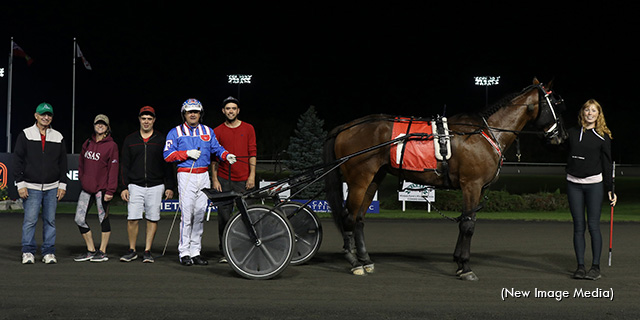
Karoline also took on equine improvement classes as her way of giving back to the horse who would give everything for her.
“I’m taking a course for equine acupuncture right now, and I also bought the Bemer blanket horse set - it’s a bit similar to PEMF MagnaWave therapy. I would practice everything I learned on Cabbie... he meant the world [to me] for everything and was always my main goal. Everything that I’ve done as a means of learning and taking new courses, I did for him - I did it for him because I thought it would help him. Sure, I will use my new skills on the other horses I look after, but Cabbie was always the driving force behind everything.”
Karoline sadly speaks of her true equine love, Cabbie, in the past tense on this occasion, because January 26, a day that should have been just another ordinary day, turned out to be one of the darkest days in her life.
“I take care of five other horses, so I would turn Cabbie out for a few hours with his buddy before I jogged him. When I would walk out to the paddock to get them, they would always be there to meet me at the gate, but on this day his buddy was pacing at the gate and Cabbie was standing up by the fence. I always bring carrots with me when I bring them in... I shook the carrots and called out to him to come to the gate, but because the field is very hilly, from the gate where I was standing, I could only see his neck up. He was standing with his ears pinned and biting at the fence, which is something he never did, and he wouldn’t come,” Karoline explains with a tone that begins to get more and more somber.
“I had to walk out to get him and when I got to him I clipped the lead-rope on and tried to pull him and he wouldn’t move. I looked and noticed that he had a tiny cut above his knee on his left leg. I pulled his blanket up and used my flashlight to get a better look at the cut and I couldn’t see anything, but yet he still couldn’t move. I yelled out to Nick to come and help me. We had to get Cabbie back to the barn somehow and as we were trying to get him to walk he was just walking on three legs... his left front leg was just dangling from his body.”
Cabbie was then rushed to the Ontario Equine Hospital in Mississauga with the hopes of finding some sort of light in what was beginning to look like a very dark time.
“We took him to the Ontario Equine Hospital where he had x-rays taken right away. It wasn’t long after the x-rays were taken that we knew there wasn’t going to be many options for him. We stood around the clinic for two hours calling every possible vet we knew, hoping that there was going to be something that we could do. We didn’t care if he was just going to be a pet for the rest of his life. We just wanted someone to give us hope that there was something we could do. I didn’t care if he could ever race or if I could ever ride him again, I just wanted there to be something we could do to save him - but there wasn’t. It crushed all of my hopes and dreams, it crushed my heart into a million pieces. The vet at the Ontario Equine Hospital was actually surprised we were even able to get him there because she said that if at anytime he was to put weight on the leg, the bone would have just gone right through the skin, that’s how shattered his leg was - she said it was the worst break she’s ever seen.”
Not knowing what exactly happened has left a lasting cloud of wonder over Karoline’s head.
“What really hurts me is the fear that maybe somewhere along the line they showed me something that said they didn’t get along, but they would walk out to the field together, they never bullied each other or fought, but when you don’t know what happened you constantly think about what you could have done or what should I have done.. you never really stop blaming yourself.”
And while she grieves terribly over the loss of her prized companion, Karoline really reflects on just how much Cabbie meant to her.
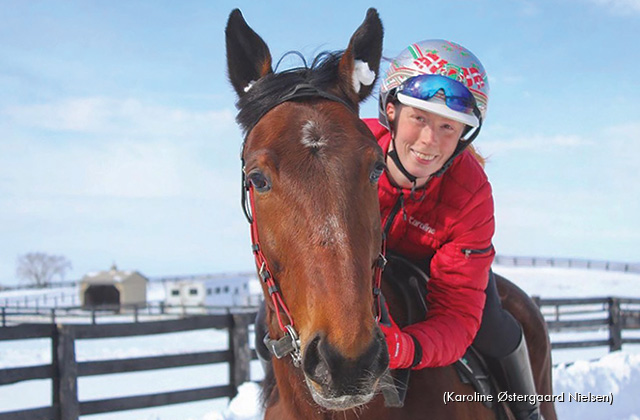
“A few drivers didn’t exactly like driving him because they thought he was a bit of an a-hole, because he could pull pretty good. Drivers have even asked me how am I able to hold him in a RUS race, but for me he was always two-fingers. He was a different horse with me - he understood me and I understood him. He was nervous when he jogged, spooking from things that weren’t there, but I was patient with him. When he’d train he’d really pull after you turned him, so I wouldn’t turn him… I’d just go the right way of the track with him from the start and eventually go a training mile with him - and he stopped pulling when he’d train. I would say to Cabbie every day ‘you can do nothing wrong, it doesn’t matter what you do - you’re never wrong.’ I’ve battled anxiety issues in my life too, and Cabbie helped me with that like I did with him. He made me feel calm, and feel good about myself. On a Sunday when I didn’t have to work I’d go to the barn to be with him anyway because he just made me feel really good about myself.
“There was one race of his that will always stand out to me - one moment. He only finished fourth too,” Karoline smiles. “He was sitting in the two-hole at Mohawk, and when they were going by the half I could see him there on the giant screen, trotting along so beautifully, and I was hit with an emotion like never before. I just looked at him on that screen and thought, ‘I am so lucky to own and care for such a beautiful, beautiful animal’. I’ll never forget how he made me feel at that moment.
“He was a horse that it didn’t take long for me to say that he was going to have a home forever. He would never have raced in a claimer or be sold because I was never going to lose him. He was a horse that turned me into a bit of a dreamer - a happy dreamer. I thought he would retire one day and was a horse that, if we ever had kids, he would be their first riding horse. I would even imagine and dread the day where he would be 32-years-old and I would have to put him down.
“For some reason I always had it in my mind that he was going to be a better horse. I always thought and I always will think that he never got to show his full potential on the race track. I think he had some issues that we finally may have found the solutions to just before the second COVID break. I was so excited to get him back racing. I know it’s easy to say now but I really thought we found the key,” she explains.
While the process of healing is never easy, Karoline has found that perhaps one of the best ways to heal is to continue being surrounded by her equine counterparts.
“I took a week off work afterwards, but then I went back. Obviously I don’t love the other horses I take care of as much as I love Cabbie, but I love them too and I think horses are very healing... I would rather be around horses than I would people,” she says in a brighter tone, as she continues to describe perhaps one of the most important things she has learned throughout this grieving process.
“As much as it hurts, I feel so blessed that I was able to have a horse that I loved as much as him, and a horse that I have had this connection with. I’ve loved other horses but I connected with Cabbie so much deeper. He is the horse that taught me so much and gave me so many experiences. He was the horse that I thought I was going to get to do so much more with in my life. I’ve always felt like I’ve never really had much to be proud of, but then I had him and he made me so proud. I’ve struggled with confidence issues my entire life and Cabbie changed that. He made me feel really good about myself and what I could accomplish. It’s hard to describe but he just made me feel like a better person.
“I have so many beautiful pictures of him but it doesn’t seem like it’s enough. I encourage people to always take pictures because when something is gone, it’s the only memories that you have left.
*******
“The pain we feel when they go is the price we pay for the love we feel when they are here.”
~ Karoline Ostergaard Nielsen.
*******
This may not be a story with the happiest of endings but perhaps this is a story that makes more of us change the ‘rules’.
Maybe, just maybe, it’s time we accept that this will never be ‘just’ a business, because we’ve all, at some point in our lives, felt like there wasn’t much left that could help us. But then it’s the soft muzzle against our cheek as we’re sad, the sweet face that rests their head on our knees as we sit in their stall, their warm exhale in our ear that calms our souls, the feeling of running our hand under their mane and down their neck, or the looking into their gentle eyes and finding all the answers we need, that saves us.
Love your horses and love every minute with them, and never be afraid of getting too attached to them, because if you’re not in this game for the love of the horse then you might be in the wrong game.


